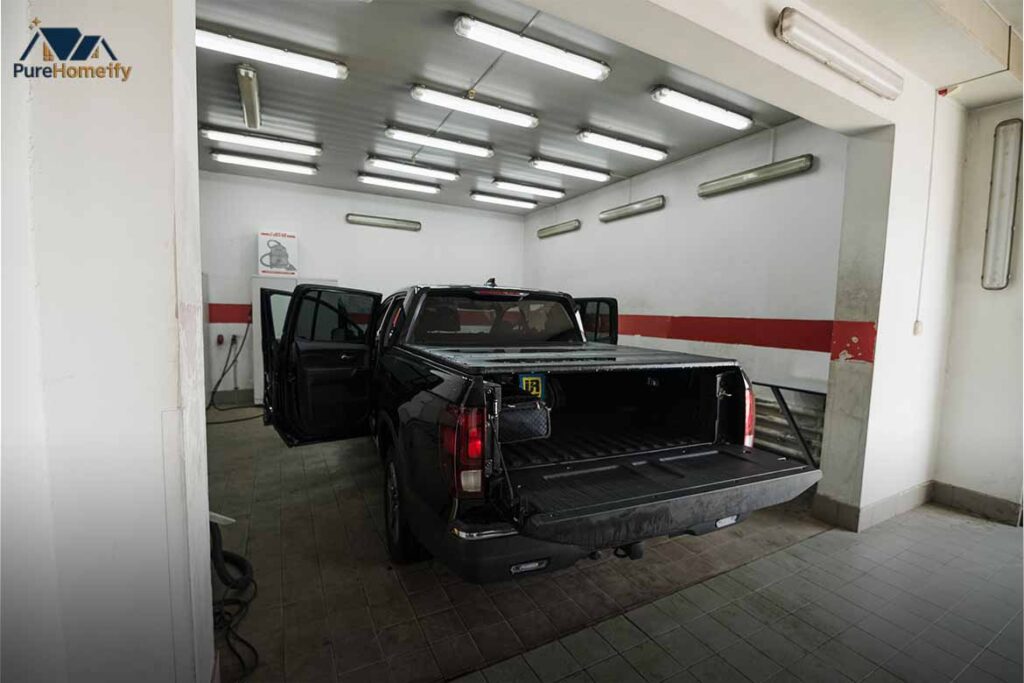When you think about your garage, you probably picture cars, storage boxes, or even a small workshop. What many homeowners overlook is the garage ceiling height. This simple measurement has a huge impact on your garage door installation, daily use, and even long-term home value. In this guide, you’ll learn why it matters, how to measure it correctly, and how to solve common clearance problems.
What Is Garage Ceiling Height and Why It Matters?
The garage ceiling height is the vertical distance from the garage floor to the ceiling. It may look like a minor detail, but it is a key factor when installing doors, lights, or overhead storage. Without proper height, your garage door will not open smoothly.
Understanding the minimum garage ceiling height for installation also protects your investment. Low ceilings can create problems for the door track, springs, or opener system. By planning ahead, you avoid costly fixes and make sure your garage supports your car, storage, and security needs.
Standard Garage Ceiling Height: Residential vs. Commercial

In the USA, the standard garage ceiling height (residential vs commercial) varies by property type. A typical home garage is usually built between eight and ten feet. This allows enough room for a standard car and door system.
On the other hand, commercial garage ceiling height recommendations are different. Businesses often need 14 to 18 feet of clearance to fit delivery trucks, service vans, or even RVs. The difference between standard residential garage dimensions and commercial setups highlights why measuring is so important before framing or remodeling.
Measuring Garage Door Headroom Correctly
Garage door headroom is the space between the top of the garage door opening and the ceiling. To measure it, you only need a tape measure and careful attention to obstacles. Start from the top of the door frame and measure up to the ceiling.
Many homeowners make mistakes because they forget about garage door obstructions (beams, ductwork, lights). In fact, the garage door headroom measurement should always account for the lowest obstruction. This ensures the tracks and springs fit without causing problems later.
Minimum Torsion Spring Headroom Requirement

Most doors in the USA use a garage door spring system (torsion vs extension springs). Torsion springs are stronger and safer, but they require more space above the door. The torsion spring headroom often starts around 10 inches and can reach 21 inches depending on the garage door track radius.
The torsion spring clearance requirements also change if you add an opener. An automatic opener headroom needs two to three more inches for smooth operation. Missing this detail can cause the opener to jam or wear out faster.
Common Ceiling Height Problems in Garages
One of the most frequent issues is older homes built with lower ceilings. These garages rarely meet the garage door clearance requirements of today’s systems. Add in ductwork or pipes, and you can see why clearance problems are common.
Another problem is poor garage door framing measurements. If the ceiling height doesn’t match the door track design, the system may strain or fail. These garage door clearance problems & solutions are usually solved with the right tracks, springs, or professional advice.
How to Convert to a Low-Headroom Garage Door
When you don’t have enough height, a low-headroom garage door conversion can help. Using a low-headroom track kit / conversion kit, installers adjust the system to fit tight spaces. In many cases, horizontal tracks or special mounts reduce the clearance needed.
The cost impact of low-headroom installation is worth noting. These kits add to the garage door installation cost, often between $200 and $500. While it solves clearance issues, it can also limit opener options. Still, these low-headroom garage door solutions are essential for homes with tight space.
Garage Height: How Tall Should Your Garage Be?

So, what’s the right size for your garage? For single-car garages, the standard garage door size (7’, 8’, 12’, 15’, 18’) and a ceiling height of at least eight feet works. For two-car garages, nine to ten feet is better.
If you own tall vehicles like trucks or RVs, you need more. The minimum garage ceiling height for installation can reach 14 to 18 feet. These figures line up with modern commercial garage ceiling height recommendations, especially for businesses with larger fleets.
Factors That Affect Garage Ceiling Height (Cars, Storage, HVAC, etc.)
Your vehicle is the first factor. Sedans fit almost anywhere, but SUVs and trucks need higher ceilings. Add a roof rack or lift kit, and the clearance must be greater. This is why garage door track radius options matter for different vehicles.
Other factors include storage and utilities. Overhead racks eat into ceiling space, while HVAC ducts and lights create obstructions affecting garage door installation. Planning ahead saves frustration and avoids costly redesigns.
Tips for Maximizing Space in Low Garage Ceilings
If your ceiling is low, creative solutions can help. Wall-mounted storage keeps boxes off the floor, while compact openers save a few inches. These changes make your garage easier to use without major construction.
Some homeowners also repaint and adjust lighting to make the space feel larger. Still, if space is very limited, the best option is a conversion kit for limited clearance. This adjustment keeps the system safe and functional.
Why Choose STI Garage Door as Your Trusted Partner
Choosing a trusted garage door company (STI Garage Door) is important when dealing withclearance issues. STI has years of experience with garage door maintenance and repair in Virginia, Maryland, and Washington DC. They understand the details of garage security and home safety.
The company also provides 24/7 emergency garage door services. This means help is available any time, day or night. When you combine expert work with reliable service, you get the peace of mind every homeowner deserves.
Conclusion
The garage ceiling height may seem simple, but it affects almost everything in your garage. From garage door clearance requirements to automatic garage door opener clearance, every detail matters. By learning the measurements and planning ahead, you avoid mistakes and keep your home secure.
If you live in Virginia, Maryland, or Washington DC, STI Garage Door is ready to help. Their knowledge, tools, and emergency garage door service 24/7 make them a reliable partner for homeowners and businesses alike.
Garage Ceiling Height Table (Quick Reference)
| Garage Type | Standard Garage Ceiling Height | Recommended Headroom | Notes |
| Residential (1-car) | 8–10 ft | 12–15 in | Fits most standard cars |
| Residential (2-car) | 9–10 ft | 15–18 in | Better for SUVs and trucks |
| Commercial | 14–18 ft | 18–21 in | Required for service vans, RVs |
FAQs
How tall is a typical garage ceiling?
A typical garage ceiling is around 8 to 10 feet in residential homes, which fits most standard garage doors.
What is the height of a standard garage?
The standard garage height is about 8 feet, though many modern garages are built closer to 9 or 10 feet.
Is a 2.3 m ceiling too low?
Yes, a 2.3 m (about 7.5 ft) ceiling is too low for most automatic garage doors and may require a low-headroom conversion kit.
Is a 7 foot ceiling too low?
Yes, a 7 ft ceiling is considered very low and won’t fit standard garage door systems without special low-headroom adjustments.
Is 2.6 m ceiling high?
A 2.6 m (about 8.5 ft) ceiling is suitable for standard residential garages and provides enough clearance for most vehicles.

